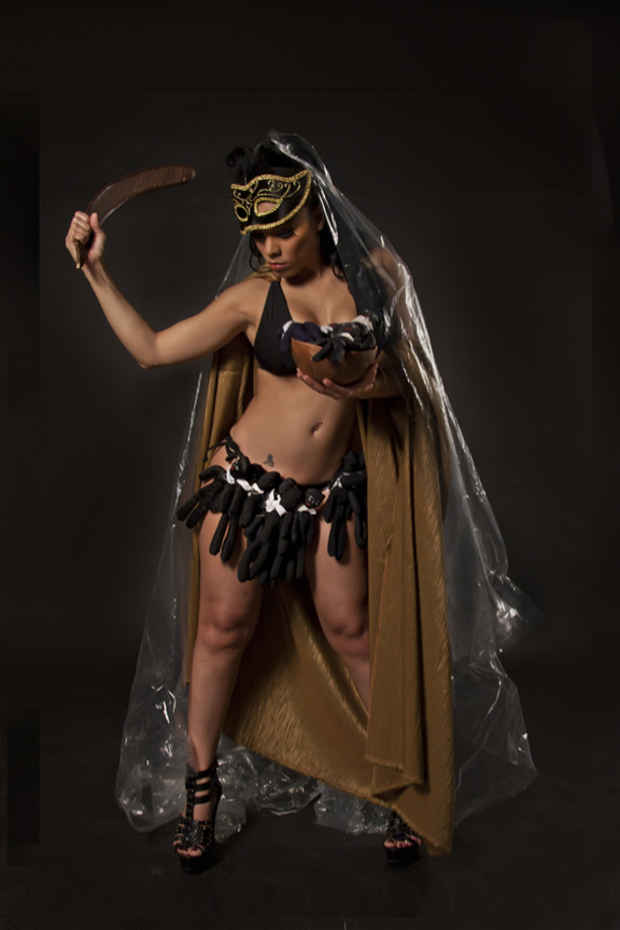Luis Carle "Santos in a Bag"
Michael Mut Gallery

This event has ended.
Santos in a Bag: A New Puerto Rican Hagiography by Luis Carle
Santos, or “holy images,” embody generations of Hispanic artistic tradition and religious devotion. They represent the aspirations and devotions of devotees to make unique spiritual and religious devotion. Santos display “soul” as emblems of devotion, but their “substance” also reveals history and meaning. Santos are intermediaries with the power to communicate with God on behalf of their devotees. Believers may ask a saint to help cure an illness, bring consolation, or avert a disaster.
A saint's power, in turn, arises from his or her ability to perform requested favors or miracles. Traditionally, santos were seen as messengers between earth and Heaven.
As such, they occupied a special place on household altars, where people prayed to them, asked for help, or tried to summon their protection.
For the believer, each santo is imbued with the saint's spirit whom they invoke through prayer to intercede with God on their behalf. For example, saints might be asked to help bring about physical healing or spiritual consolation, to help one find a mate, or to ensure the safe return of a loved one.
Saints are rewarded for favors granted with modest offerings of flowers and milagros (miniature representations in silver or other metal symbolizing parts of the body that had been healed from disease or injury).
Special celebrations are held on the memorial or feast day of a favorite saint who is honored as the patron guardian of the household or of the community. These elaborate festivities, also known as fiestas patronales, bring people together for prayer, music, food, and socializing, and involved special rituals such as the velorio (prayer vigil accompanied by music) or rosario cantado (rosary prayers accompanied by religious songs).
The Puerto Rican art of the santero (artisan wood carver) has served a devotional purpose for three centuries. Today the santos embody devotional, artistic, and cultural attributes that reflect the past, but look forward to the future. Santeros carved portable images of Catholic saints for many rural households in Puerto Rico and other Latin countries in the “New World”, following a religious craft tradition that hailed back to Spain. They traditionally fulfilled their mission as spiritual intercessors. In earlier times the image carvers of were not recognized as artists, but instead earned their reputation based on their spiritual efficacy, being called to their work by divine inspiration. Santos makers may carve parts of the figure separately. The figure's clothing and pose, as well as its attributes – the symbols associated with a particular saint such as flowers, swords, chalices, keys, or wings – can provide clues to their specific identity.
In the Santos in a Bag series, Puerto Rican photographer Luis Carle is experimenting with a new visual language that reinterprets the traditional imagery of the santos, not only as Catholic saints, but also in their syncretic manifestations within the santería tradition. Although born into a Catholic household, Carle did not grow up with a marked influence of the patron saints and their lore in his immediate domestic sphere. Following an earlier documentary project during the late 1990's that focused on exposing the malice of the pirate santeros who stole ancestral santos from rural homes to sell them to private collectors, his curiosity about these sacred images has continued to grow. After a challenging period in his personal life, his own spiritual quest has also brought the photographer closer to their spiritual arena, where intercession became a source of solace.
In his new Santos in a Bag series, Puerto Rican photographer Luis Carle experiments with a new visual language that effectively reinterprets traditional imagery into a new light. In some cases, Carle goes as far as inventing new types meant to address the particular circumstances and needs of their subjects based on what he coaxed from his conversations with individual models.
Unexpected, spontaneous combinations of props literally manifested before him as he worked with his models, resulting in inventive compositions that elaborate on the familiar imagery without being repetitive.
Throughout the series Carle explores the notion of spiritual ambivalence. In some cases he playfully explores the Jungian archetypal divine marriage between female and male energies – the Hieros Gamos as the union of the anima and the animus - by resorting to representations of androgyneity in a number of his photographs. The female and male energies each santo is meant to manifest result in portrayals simultaneously reify and contest sexual stereotypes.
Written by independent curator Anabelle Rodríguez, in collaboration with Luis Carle, José Vidal and Carlos Manuel Rivera.
New York City, July 2012
Media
Schedule
from July 25, 2012 to July 31, 2012
Opening Reception on 2012-07-25 from 18:00 to 20:00